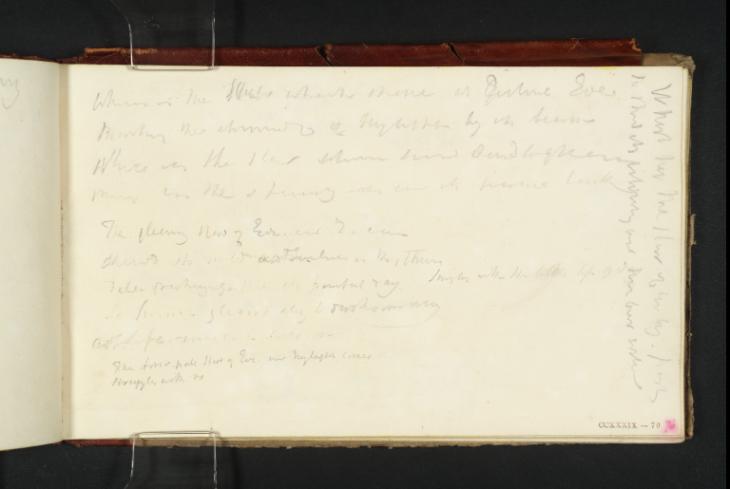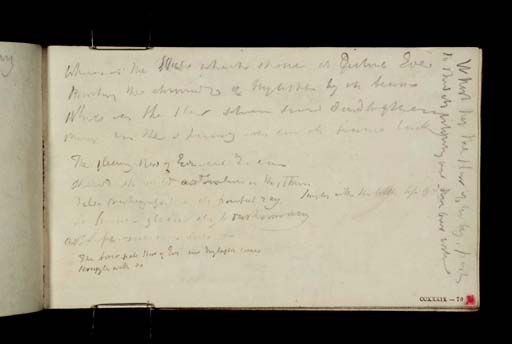Joseph Mallord William Turner Inscription by Turner: A Draft of Poetry ?1831
Image 1 of 2
Joseph Mallord William Turner,
Inscription by Turner: A Draft of Poetry
?1831
Joseph Mallord William Turner 1775–1851
Folio 71 Recto:
Inscription by Turner: A Draft of Poetry ?1831
D22279
Turner Bequest CCXXXIX 70
Turner Bequest CCXXXIX 70
Pencil on white wove paper, 114 x 191 mm
Partial watermark ‘nard | 20’
Inscribed by Turner in pencil with a draft of poetry (see main catalogue entry)
Inscribed by John Ruskin in red ink ‘70’ bottom right
Stamped in black ‘CCXXXIX – 70’ bottom right
Partial watermark ‘nard | 20’
Inscribed by Turner in pencil with a draft of poetry (see main catalogue entry)
Inscribed by John Ruskin in red ink ‘70’ bottom right
Stamped in black ‘CCXXXIX – 70’ bottom right
Accepted by the nation as part of the Turner Bequest 1856
References
1909
A.J. Finberg, A Complete Inventory of the Drawings of the Turner Bequest, London 1909, vol.II, p.736, CCXXXIX 70 (as ‘Do.’, i.e. ditto; ‘Draught of verses’, as for folio 70 verso,D22278; Turner Bequest CCXXXIX 69a, with partial transcription: ‘Possibly a reference to the picture now called “The Evening Star”, 1991, N.G., which I believe was painted about this time.’).
1910
C[harles] Lewis Hind, Turner’s Golden Visions, London and Edinburgh 1910, p.153, with partial transcription.
1964
Jerrold Ziff, ‘J.M.W. Turner on Poetry and Painting’, Studies in Romanticism, vol.3, no.4, Summer 1964, p.194 note 8.
1966
Jack Lindsay, J.M.W. Turner: His Life and Work: A Critical Biography, London 1966, p.172, with partial transcription.
1969
John Gage, Colour in Turner: Poetry and Truth, London 1969, pp.144, 259 note 82.
1972
Henning Bock, ‘Die Marinebilder’ in Werner Haftmann, Andrew Wilton, Henning Bock and others, J.M.W. Turner: Gemälde Aquarelle, exhibition catalogue, Nationalgalerie Staatliche Museen Preußischer Kulturbesitz, Berlin 1972, p.39, with partial transcription.
1984
Martin Butlin and Evelyn Joll, The Paintings of J.M.W. Turner, revised ed., New Haven and London 1984, p.285 under no.453, with partial transcription.
1987
John Gage, J.M.W. Turner: ‘A Wonderful Range of Mind’, New Haven and London 1987, p.246 note 8.
1998
Judy Egerton, The British School, National Gallery Catalogues, London 1998, p.290 (as c.1829–30, with partial transcription).
2001
Martin Butlin, ‘Evening Star, The’ in Evelyn Joll, Martin Butlin and Luke Herrmann (eds.), The Oxford Companion to J.M.W. Turner, Oxford 2001, p.95, with partial transcription.
The page is taken up with lines of verse. Most commentators have followed Finberg’s patchy transcription of the first, fifth, tenth and eleventh lines (‘“Where is the star which shone at ... Eve” – | “The gleaming star of Ever ...” – | “The first pale Star of Eve ere Twylight [sic] comes | Struggles with ...”’) in full or in part.1
John Gage usefully added ‘the little life of day’, as if part of the last line,2 although the whole phrase is actually an addendum, continuing or inserted to the right of line seven; Judy Egerton picked out a few further key words, as quoted below.3 The fuller transcription attempted here is very tentative, and some words could be read differently, although the overall sense is clear:
Where is the Star which shone at [?Evetime] Eve
R[or ‘B’...]ing the [...] of Twylight by its beam
Where is the star [...] suns [... ?lengthen...]
[?Shining] in the [...] its [...]
The gleaming star of Eve [...] T[...]
Shewd its mild [... ?sunshine] in the [?Th...]
[?Pale ...] its powerful ray. Struggles with the little life of day.
So [?Sun...] gleams to [...] [?our way]
[‘As’ inserted] [?of Life ...]
The first pale Star of Eve ere Twylight comes
Struggles with [...]
R[or ‘B’...]ing the [...] of Twylight by its beam
Where is the star [...] suns [... ?lengthen...]
[?Shining] in the [...] its [...]
The gleaming star of Eve [...] T[...]
Shewd its mild [... ?sunshine] in the [?Th...]
[?Pale ...] its powerful ray. Struggles with the little life of day.
So [?Sun...] gleams to [...] [?our way]
[‘As’ inserted] [?of Life ...]
The first pale Star of Eve ere Twylight comes
Struggles with [...]
With the page turned vertically, Turner wrote a further couplet along the outer edge:
Where [...] the Star of Evening [?parting]
So that its [...] the b[...]
So that its [...] the b[...]
There are briefer related passages on folios 3 recto and 4 verso (D22155, D22157), and longer ones on folios 70 recto and verso opposite (D22277, D22278; Turner Bequest CCXXXIX 69, 69a). A virtually illegible passage on folio 20 verso (D22186) may also begin ‘Lo Twilight’ (or ‘Twylight’). It is unusual to find such lengthy drafts in a sketchbook from this stage of Turner’s career,4 although they are characteristically repetitious and unresolved; most of his poetry was composed some two decades or more previously, although he continued to accompany his paintings with fragmentary lines from his ‘M.S. Fallacies of Hope’ in Royal Academy exhibition catalogues until the end of his career.5
As Egerton observes, ‘Turner makes one attempt after another to find poetic expression for an inevitable sequence common enough in nature: the sequence in which the “pale” evening star appears with its “mild” light (if “mild” is indeed decipherable) at twilight, and briefly “gleams” before its light is overtaken by the “powerful ray” of (presumably) the moon.’6 She notes that he was ‘deeply interested in such transitional moments’, later slightly adapting Lord Byron’s ‘The moon is up and yet it is not night – | Sunset divides the sky with her ...’7 when exhibiting Modern Rome – Campo Vaccino in 1839 (J. Paul Getty Museum, Los Angeles);8 he used the couplet again in a slightly different form for Approach to Venice in 1844 (National Gallery of Art, Washington DC).9
The lines here were first tentatively linked by Finberg10 to the unfinished painting The Evening Star, of about 1830 (Turner Bequest, National Gallery, London),11 a near-empty twilight beach scene, and later commentators have relayed this idea with varying degrees of agreement.12 Gage proposed that Venus, the Evening Star, a figure subject exhibited at the Royal Academy in 1828 by William Etty (1787–1849), might have set Turner thinking on the theme.13 Introducing a certain circularity to the discussion, Egerton has suggested that the title of his unfinished, unexhibited painting ‘is unlikely to be Turner’s’, and ‘seems to have been invented for it in 1906’, possibly even at Finberg’s ‘inspired suggestion’ after deciphering these verses.14 At any event, if the lines do relate to Turner’s so-called ‘Evening Star’ canvas, they are ‘characteristic of his longing to find poetic expression for what he had, perhaps at the same time, perfectly caught in paint’.15
Matthew Imms
April 2014
See Andrew Wilton and Rosalind Mallord Turner, Painting and Poetry: Turner’s ‘Verse Book’ and his Work of 1804–1812, exhibition catalogue, Tate Gallery, London 1990, including transcriptions from a broader timespan, pp.149–81, although the present lines are not addressed.
Egerton 1998, p.290; see also Gage 1969, p.144 for Turner’s move from mythological to naturalistic pictorial representations of such themes.
See Hind 1910, p.153, noting that the ‘Official Catalogue’ at that time dated the painting to about 1840; Lindsay 1966, p.172; Gage 1969, p.144, suggesting that the verses and painting are ‘possibly, though hardly obviously’ connected; Butlin and Joll 1984, p.285; Butlin 2001, p.95.
How to cite
Matthew Imms, ‘Inscription by Turner: A Draft of Poetry ?1831 by Joseph Mallord William Turner’, catalogue entry, April 2014, in David Blayney Brown (ed.), J.M.W. Turner: Sketchbooks, Drawings and Watercolours, Tate Research Publication, September 2014, https://www


